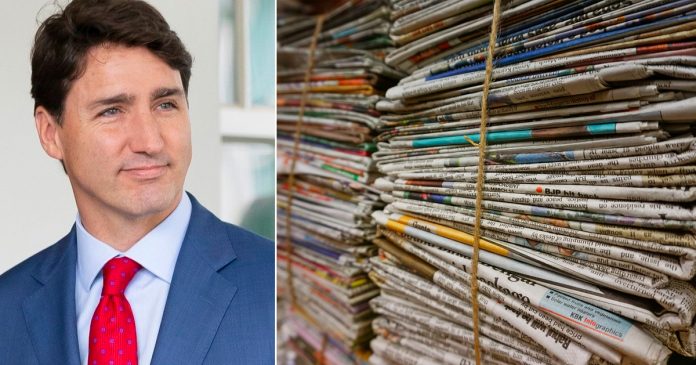Carleton University’s School of Journalism held a panel discussion with members of the legacy media on Tuesday to discuss their role in covering what the school called “the siege of Ottawa” by “the so-called freedom convoy.”
Before it even took place, the event received backlash online for its biased tone and the apparent exclusion of independent and right-of-centre journalists.
Given that I live in Ottawa and had spent a good amount of time covering the Freedom Convoy for True North, I thought I would attend the event, and with an open mind.
I was asked for proof of vaccination and screened for COVID when I arrived at the event even though Ontario had dropped vaccine passports on March 1.
The panel featured CBC’s Judy Trinh and Jorge Barrera, the Toronto Star’s Raisa Patel, CTV News’s Glen McGregor, left-wing investigative journalist Justin Ling and photographer Justin Tang.
Carleton journalism associate professor and CBC News anchor Adrian Harewood was the moderator for the evening.
The MC began by acknowledging that the relationship between the Canadian public and the legacy media has changed, and Harewood recognized an erosion of public trust.
National Post columnist Rupa Subramanya, who had received a late invitation to join the panel, was not able to attend the event due to scheduling issues. Instead, she offered remarks in a pre-recorded video.
Subramanya called out the framing of the event, as well as the negative tone the legacy media had adopted while covering the convoy. She also touched on civil disobedience in India, including the 2020-2021 farmer protests, which Prime Minister Justin Trudeau had supported.
While some panellists seemed defensive following Subramanya’s remarks, others made comments later that evening that seemed to reaffirm what she had said.
Despite the overwhelming consensus in the legacy media that the Freedom Convoy protesters were hateful towards them, not all journalists at the panel seemed to have experienced something truly negative.
Photojournalist Justin Tang talked about the importance of journalists dressing to blend in, saying that he chose not to wear a mask because it would have drawn negative attention. By carrying himself in a way that was non-threatening to protesters, Tang said, he was able to do his job.
I myself observed while covering the Ottawa protests that Freedom Convoy demonstrators were very wary of the legacy media. Part of the reason for this distrust is the disconnect between rural and urban Canadians, as well as between the elite and the working class.
Panellists mentioned how journalism used to be a blue-collar profession but that today, legacy media journalists are seen as part of the social elites. The majority of these “social elites” live and work in cities, as legacy media offices are usually found in downtown cores.
The panel acknowledged that legacy media under-reports rural communities, with CBC’s Judy Trinh saying, “when was the last time we travelled outside the downtown core to west Carleton?” (a rural area outside of Ottawa)
According to Trinh, people in rural communities have been ignored by the media, similar to how the media has ignored people of colour.
Race was a prominent topic throughout the night. Near the end of the event, an attendee asked why the media was considering reaching out to white right-wingers who are occupying a city to rebuild their trust, but not to people of colour who have been oppressed for years.
To this, Trinh acknowledged that there are issues with how the legacy media has covered minority communities. Harewood, who is black, added that the media needs to be more comfortable discussing race.
There was also a question about media bias, asking if journalists believe that they can be fully objective.
CBC’s Jorge Barrera answered the question by stating that he does not think journalists should be objective, but rather impartial. He added that as a journalist, he is aware of his biases.
The panel was then asked about “citizen journalists,” who, along with independent reporters, played a crucial role in covering the historic Freedom Convoy protests in Ottawa.
Trinh said that she was concerned about the fact that everyone with a camera is considered to be a citizen journalist. The Star’s Raisa Patel added that certain contexts and skills are needed to do proper journalism.
Justin Ling said that citizen journalists have biases, and chose to aim their cameras intentionally at what they wanted people to see.
I thought to myself, doesn’t the legacy media also do this?
I recall during the convoy coverage that most of the clips showing demonstrators cleaning up garbage, shovelling the streets and handing out food had come from citizen journalists. Meanwhile, the legacy media seemed to focus more on the one unknown person who had brought a Nazi flag.
As the event came to an end, the MC said that the conversation the panel had was needed, and was just part of a beginning.
I couldn’t agree more.
I had just heard members of the legacy media openly admit that their industry ignores rural Canadians and has racial biases. Moreover, these journalists know they are not objective, and that trust has eroded.
What I took away from this event is that the legacy media has flaws, and that they know that. People are right to question their credibility, and I believe we should not accept everything they say as truth, but rather do our own independent research and confidently come to our own conclusions.

